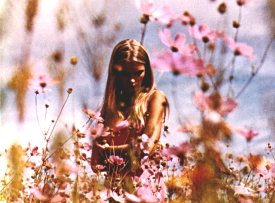

the conservatory
The Free DesignThe Free Design story is a remarkable one: four young siblings wrote and recorded six albums with the support of their father (a professional trombonist), between 1966 and about 1972. Chris Dedrick, the eldest brother, penned clever and catchy tunes like "Kites are Fun", " I Found Love", "Bubbles" and the wry "2001: a Hit Song", while the four youths blended their voices into lovely close harmonies. Orchestration was perfect, with Enoch Light's capable production. The music got raves from critics, but the big record corporations didn't know how to market the sweet, jazzy music - especially at a time when bands like the Rolling Stones dominated record sales. Too jazzy for the pop audience, too poppy for the jazz crowd, the Free Design faded into obscurity by the mid-'70s. Skip forward a couple of decades. Jazzy electro-pop hipsters Stereolab cited The Free Design as a major influence; soon their fans were scouring the bins for anything they could find. The result? More Free Design records were selling at the turn of the 21st century than when they were first released! The Siesta label out of Spain has repackaged a lot of their work, but the essential collection of it is "The Best of The Free Design: Kites are Fun", on the Varese Vintage label. Amazingly, the siblings returned to the studio in 2000 for a new album of original tunes! And thankfully, it isn't much different from the music they recorded 30 years ago: beautiful, optimistic, unique. Laura NyroLaura Nyro is far better known as a songwriter than a singer or pianist, but in fact she excelled at all three. Many of her songs - "And When I Die", "Stony End" and others - were big hits for other singers, but most of them can be found in their original state on her 1967 recording "Eli and the Thieteenth Confession". Nyro was one of the few pop/rock songwriters of her time to turn out anything approaching poetry (more so than the oft-quoted Bob Dylan nee Zimmerman), and most closely parallels Leonard Cohen. Like Cohen, Nyro's subjects often focussed on the grittier aspects of urban life, with addicts, abandoned people and such, with great effect. Still, many of her songs were joyous, and none ever stooped to being maudlin. She drew heavily from jazz composition and beat poetry, with a manic energy of her own. Standouts include the aforementioned "Stony End", "Once it was Alright Now", "Sweet Blindness" and "Lonely Women". Sadly, Nyro died of cancer a few years ago, while in her 50s. TogetherYou might have heard of a group called The Yardbirds. In 1968, they basically imploded, with recent addition, guitarist Jimmy Page, turning them into Led Zeppelin. Yardbirds founders Keith Relf, Jim McCarty and Paul Samwell-Smith went their own way and formed a group called "Together", recording seven songs in preparation for an LP. Unfortunately, with two of the three musicians fighting various addictions, it was never completed and only one single was released; three of the remaining tunes were lost. The four that still exist are collected on the fine double CD "Little Games Sessions and More" on the EMI "Legends of Rock & Roll" label. Quite a departure from the usual Yardbirds blend of R&B and psychedelic guitar work, the cuts by Together are melodic, occasionally lush. The song "Henry's Coming Home" is jangly and angular. "Together Now" is even a bit grand, and exhibits a fresh sound unmatched by any other group of the day. "Shining Where the Sun has Been" is probably very similar, but it was never pressed beyond an acetate, so the sound is thin; it sounds more like a demo. What a shame that factors weren't more conducive to the completion of this record; it would've been a pop-psych masterpiece. AfterglowMany of even the most dedicated fans of obscure psychedelia are unaware of the existence of Afterglow, a band from Oregon. They recorded but one album, between college semesters in 1968. The music is reminiscent of the Byrds and the Strawberry Alarm Clock, but also is fresh and innocent in ways that both of those bands were not. Most of the tunes are light and poppy, with a couple of standouts: "Riding Home Again", "Dream Away" and "Meadowland of Love" are soft and melodic, while "Susie's Gone" is surprisingly psychedelic. The album never received any serious promotion and soon Afterglow broke up and faded away. Still, the record they left (and now available on the Sundazed label) is well worth adding to the collection of fans of pop music of the late '60s. Billy NichollsAnother "almost" superstar of the '60s was British Billy Nicholls. At 16, he approached George Harrison of the Beatles to ask for help getting his songs heard. That led, circuitously to him recording an album on the Immediate label a couple of years later. For reasons still unclear, it was only released to radio stations, then shelved. Nicholls did continue to work in the music industry, but always behind the scenes. This is a strange and unfortunate fate, as he was appealing, possessed a decent voice and wrote fine pop songs. Heavily influenced by "Pet Sounds" by Brian Wilson/Beach Boys, he incorporated many psychedelic influences into his intricate tunes. His album - titled "Would you Believe?" also featured many of the biggest talents in British pop at the time, from Nicky Hopkins and John Paul Jones to Steve Marriott. Due to its scarcity, surviving copies of "Would you Believe?" became hugely valuable. Thankfully, it recently was released on CD, giving an glimpse into one of pop music's most intriguing "what might've beens". NicoYou probably have heard Nico's voice on some of the cuts on the Velvet Underground's 1967 debut album. Although never officially a member of the VU, her voice and presence added much to their image. She had no musical training (most of her pervious experience was as a top fashion model!) but she had a singular vision for music which she pursued over the next two decades. Her voice was unique: a heavy contralto with a German accent, it sounded impossibly world-weary, yet fragile. She also chose some rather unusual musical background - sometimes just a harmonium, strings at other times. Her lyrics were intensely personal, about her loves and losses, and her songs could feel a bit too intimate and revealing at times. Alain Delon fathered a son by her, then abandoned her. She in turn abandoned the child to an aunt, later returning to reclaim him, only later to introduce him to heroin (an addiction that bedeviled her for most of her adult life). Still, her music is an important and often moving document of her life and millieu. Her first album -- "Chelsea Girls" -- from 1968 is probably her best. She died of a cerebral hemorrhage in 1988. The Left Banke"Walk Away Renee" is the only song most people know by The Left Banke. A big hit in 1966, it introduced the band's unique blend of pop and baroque influences with touches of country and pqychedelia. Lead singer Steve Martin had a fine tenor voice, well supported by the harmony from the other members. Sadly, the harmony did not extend past the music and the group was torn apart by internal conflicts, part of which were caused by jealousy. Member Tom Finn innocently introduced his girlfriend Renee to the band. The group's pianist and composer Michael Brown (nee Lookofsky) whose father was the band's manager, immediately became infatuated with her, writing three of the group's biggest hits about her. Brown's father, the rest of the band members felt, showed preference towards him, which caused more friction. Within two years, after recording their second album, it was all over for the band. What remains is a fine collection of songs in a style quite unlike any other's. They have been collected into their entire output called "There's Gonna be a Storm", available on Mercury/Polygram. The Left Banke remain as one of the most individual sounding groups in an era dominated by the Beatles. Margot GuryanMs. Guryan is best known as a songwriter, but had quite a pleasant voice herself. The one solo record that we've heard ("Take a Picture") has some nice moments. By far, the standout cut is the shimmering song "Sun", which ranks up there with the sweetest pop of its day. "Sun / Lying in the sun / Not a lot of rain in the winter / All I want is the sun / Doesn't everyone / need a little rain from time to time? / All I want is the sun / to shine / And doesn't it feel good?" Yes, indeed. You could call "Take a Picture" Guryan's "Pet Sounds". Like Brian Wilson's legendary project, it's uneven, but when it works, it is transcendent. the cabaña the space station the lounge the cabaret the jazz club the concert hall the trip the screening room |